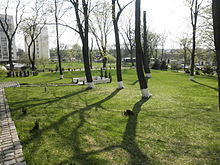Mendeleevo

Mendelejewo (German Juditten ) is a district of Kaliningrad (Königsberg (Prussia)) .
Surname
The original name is derived from Prussian and describes the landscape: "gaudis" (wistful), "juodas" (black, dark).
history
Like the rest of Samland, the region populated by Prussia was conquered by the Teutonic Knight Order in the 13th century and incorporated into the state. In 1287 the place is mentioned for the first time as " duas villas sic nominatas Gaudityn ". In 1349 it says “super villam Gauditin, Gauditen” and 1302 Judyn churches. The name Juditten appears in the East Prussian folios in 1670. At Juditten there was the Spittelhof, the farm yard of the house commander of Königsberg, to whom the villages belonging to the hospital were subject to scrutiny.
In 1874 the Juditten district was formed from the rural communities Lawsken, Moditten, Spittelhof and Waldthal, the estate districts of Charlottenburg, Friedrichswalde, Groß Rathshof, Klein Rathshof and Moditten and the Juditten Mühle establishment. The district was administered by the mayor in Rathshof. On June 16, 1927 Juditten was transferred to the municipality and the city district of Königsberg i. Pr. Incorporated.
From the cemetery there was a good view of the Pregel and the Fresh Lagoon .
Theodor Krohne received the Juditter grove, which was named after him.
The mass extinction of the remaining German population in Königsberg from 1945 to 1947 also affected Juditten. Many victims of hunger, cold and epidemics were buried in mass graves south / below the church.
church
The Juditter Church was built at the end of the 13th century by the Teutonic Order as a fortified church. It is one of the oldest churches in Samland . Queen Luise often visited this church during her stay in Königsberg. Before the Reformation, Juditten was a famous place of pilgrimage because of the Madonna on the crescent moon , a superhuman size image of the Virgin with Child Jesus, roughly carved from wood and painted . Even after the Reformation, pilgrims came, even from Rome, and had the Lutheran pastor give them a certificate stating that they had repented. The church fell into ruin during the Soviet era, and was rebuilt in the 1980s after it was transferred to the Orthodox Church until 1990.
In the 1930s, another church was built in a newly built district of Juditten, which has been used as a cultural center since the Soviet era, which has been greatly modified.
Personalities
- Johann Christoph Gottsched (born February 2, 1700 in Juditten, † 1766), German writer, dramaturge, and language and literary theorist
- Erika Durban-Hofmann (* 1922 in Juditten; † December 21, 2005 in Unterschleißheim), painter, graphic artist and book author
literature
in order of appearance
- Ludwig von Baczko : Attempting a history and description of Königsberg , Königsberg 1804
- Materials on the history of the Juditten church near Königsberg i. Pr. In: Archives for patriotic interests . New series, year 1845, Marienwerder 1845, pp. 725–745.
- George Adalbert von Mülverstedt : About the name of the church Juditten. Lecture at the assembly of the Prussia on October 1st. Held in 1853 . In: Prussische Provinzial-Blätter , Volume 4, Königsberg 1853,
- Ernst Ludwig Storch: The church and the parish Juditten in the district of Königsberg. A contribution to the patriotic, church and cultural history of Prussia . Königsberg 1861. ( full text )
- Georg Hermanowski : East Prussia Lexicon . Mannheim 1980, p. 155.
- Fritz Gause : Königsberg in Prussia . Leer 1987.
- Grasilda Blažiene: The Baltic place names in Samland (= Hydronymia Europaea , special volume II). Steiner Verlag, Stuttgart 2000, ISBN 3-515-07830-4 , p. 50 f.
Coordinates: 54 ° 44 ′ 0 ″ N , 20 ° 29 ′ 0 ″ E


